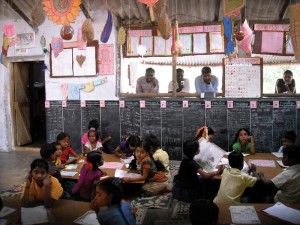 Despite the Right to Education becoming a fundamental right in 2010, survey after survey paints a grim picture of education in India. Raushan Kamdar attempts to analyse the key issues
Despite the Right to Education becoming a fundamental right in 2010, survey after survey paints a grim picture of education in India. Raushan Kamdar attempts to analyse the key issues
After being complacent for too long, in 2010 the UPA Government took its first concrete step in ensuring its little citizens a life of dignity. It brought us closer to the ideal of a democratic and egalitarian society by bestowing upon us the Right to Education (RTE).
Education is a national priority. It is a matter directly concerning the youth and its future. It is thus time for the youth to proactively engage and initiate, to join hands with the advancing efforts of NGOs, academic institutions, government and activists, and free education from the coagulum of flaccid governance and lax implementation.
KNOW YOUR RIGHT
RTE guarantees free and compulsory education to all children between 6 and 14 years of age. It also specifies certain norms that every educational institute must adhere to, such as no acceptance of donation or capitation fee, no interview of the parent or child for admission, the correct student-teacher ratio, 25% caste-based reservation in private schools, and a number of other provisions regarding improvement of infrastructure, faculty and more.
GROUND REALITY
On paper this law will revolutionise education in India, however, reality is far from that. According to the official report released on the first anniversary of the RTE by Kapil Sibal, 8.1 million children aged 6 to 14 years remain out of school, and there is a shortage of 5 lakh teachers countrywide. Only 5 states have notified rules to implement the RTE. According to the Annual Status of Education Report (ASER), although some of the infrastructural parameters have improved, it’s far from where it should be. For instance, 27% of all schools visited had no drinking water facility in 2012 and only 56.5% of schools had useable toilets, while the mid-daymeal was served in 87% of the schools. The desired student-teacher ratio was missing in nearly 60% of the schools. Says Ambarish Rai, a Delhi based spokesperson of the RTE forum, “Basic necessities are not available in a large number of government primary schools. This is the sad state of affairs and the dream of universal elementary education still remains a distant reality for millions of children.”
QUALITY OF EDUCATION
Civil rights activist and political analyst Anand Teltumbde finds fault with the education system, especially in rural education, which, he says, is cut off from quality education. “Villages in the early decades of Independence contributed brilliant people to this nation. Most statesman and high-ranking people had come from villages only because of quality education,” he claims.
While the RTE talks about guaranteeing free and compulsory education to every child in India, it doesn’t mention the kind of education they must be given. For instance, there are evident differences in the education offered in private schools and that in government schools. The latter is the largest provider of elementary education in India, but is still marked by mismanagement, inefficiency, poor infrastructure, low funds, abysmal salaries for teachers, etc. Children attending private schools are seen at an advantage, while the weaker sections of society have no option but to attend poorly managed government schools.
The act is thus criticised for being discriminatory by catering only to the urban and rural elites and thereby widening the gap between haves and have-nots. The survey by ASER also revealed that most children in primary schools today are at least three grades behind from where they should have been now.
How much our education transforms into gainful employment for these children when they enter the competitive world is a question we are yet to find an answer to. Indeed, companies like Tata and Infosys are hiring people who they do not consider to be up to par, and spend 6-9 months, sometimes longer, to educate them properly for their jobs.
YOUTH’S RESPONSIBILITY
Despite efforts, millions of children today are deprived of an education, of inspiration, of dreams, of spirations and ambitions. While we decide for ourselves the best universities, scholarship applications, statement of purpose, etc, why not take out some time to help educating those within our ambit at least? This one small deed can empower someone for life and give them the wings to fly a great distance. We, the ones reading and writing this are among the fortunate few who have managed to get a decent education against all odds. The best way to repay this gratitude is to help someone else get one too. Sign up at an NGO, call up your maid-servant’s kid, or walk up to a street-child – do your bit and spread smiles.
NGOs TO GET INVOLVED WITH
* Teach for India
* Each One Teach One
* CRY
* Pratham
“There are 540 million Indians under the age of 25. India’s favourable demographic profile can add significantly to its economic-growth potential for the next three decades, provided that its young people are educated and trained properly. India spends only 1.2% of its GDP on higher education, compared to 3.1% in the US and 2.4% in South Korea. The figure should be higher. So, too, is India’s 3.3% share of global output of academic research far too low for a country with 17% of the world’s brains.”
– Shashi Tharoor, former Minister of State for Human Resource Development
Volume 4 Issue 1

























